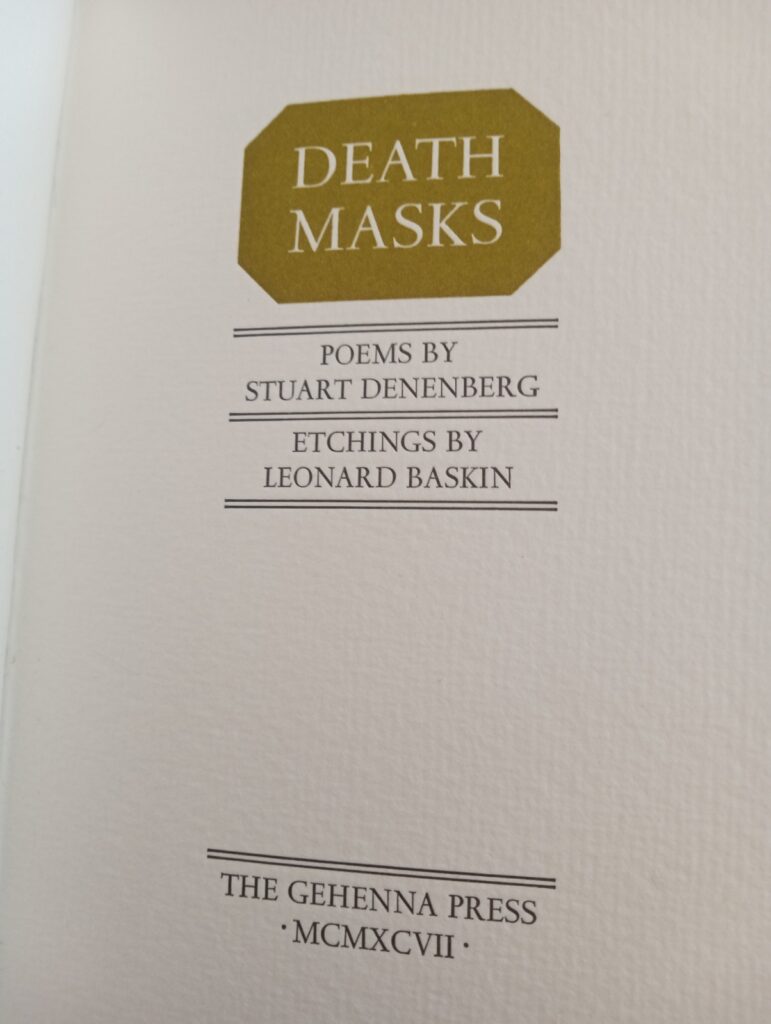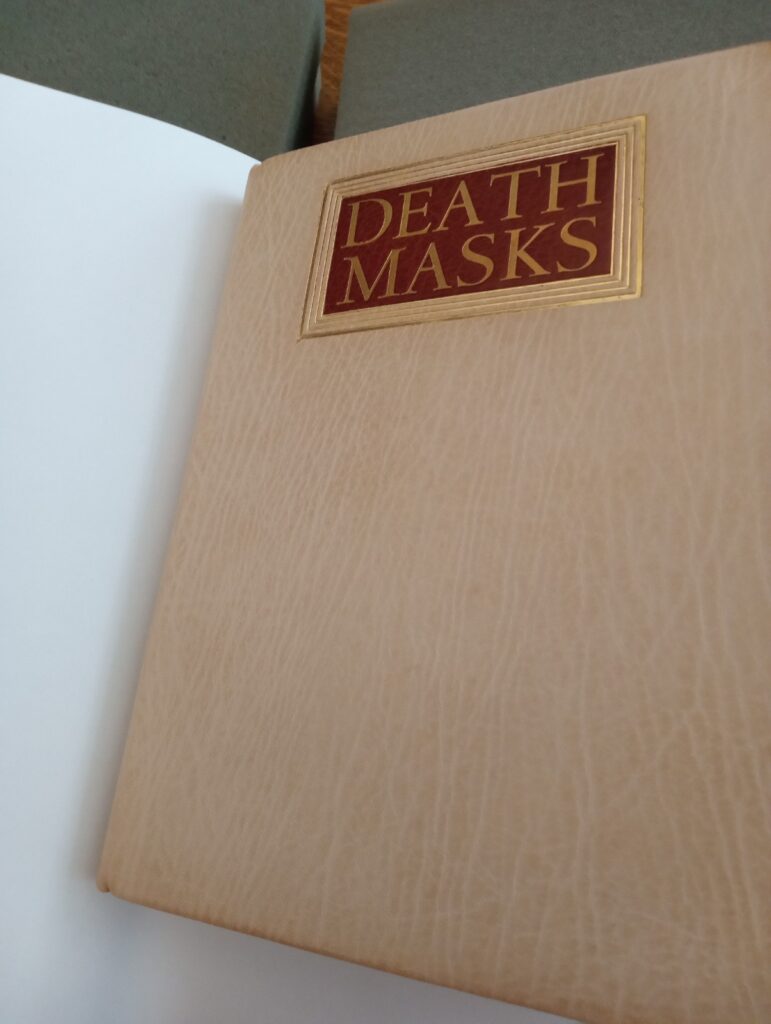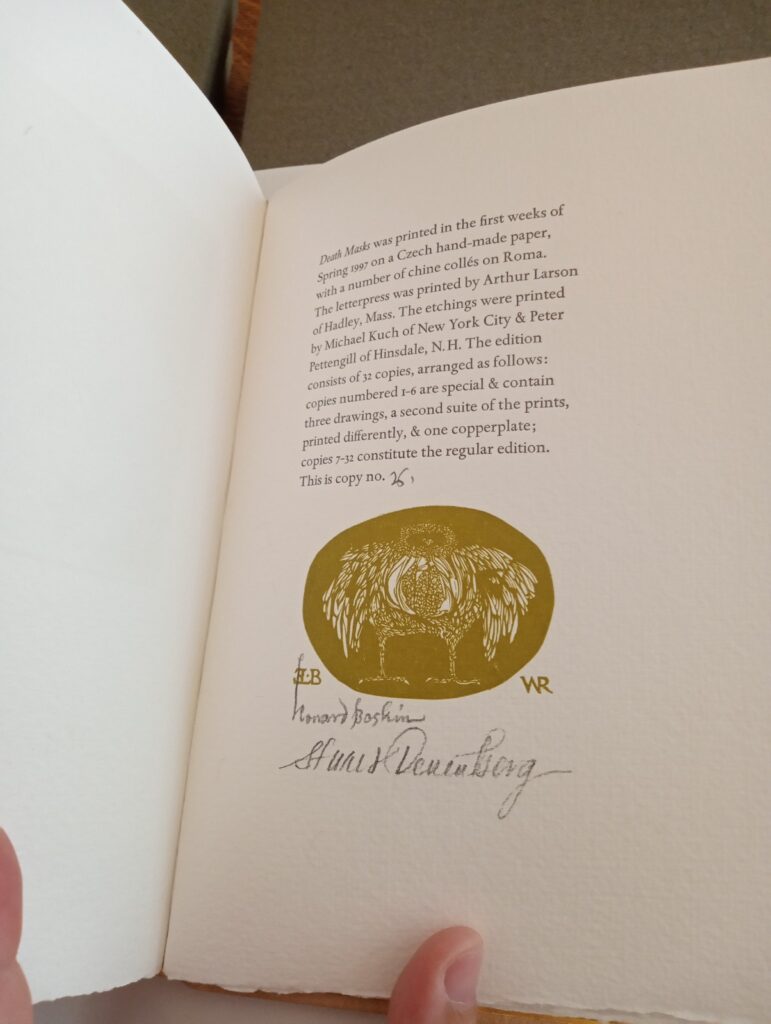My Pet Book’s afterlife
Reading over my past blog posts, I recognize how wheedled I’ve become by the topic of death. So I’m glad that the topic of this blog is afterlife. The afterlife of my pet book Death Masks. It looks brand new. It helps that the book was only recently made, published in 1997.
The edition consists of 32 copies.
On the description of the book, it states as follows:
copies numbered 1-6 are special & contain three drawings,
a second suite of the prints, printed differently. one copperplate;
copies 7-32 constitute the regular edition”-Colophon
I can’t be sure exactly how to translate that description. I don’t believe that the second suit constituted a second edition of the book. However I could not find a date for a second edition. I didn’t think there was a second edition of my pet book. I only started to consider it when I read on World Cat that there are 2 editions in 20 libraries. So I’m going to decide that the 2 editions referred to are copies 1-6 and the other copies 7-32.
Wesleyan Special Collections copy: 26 of the limited, signed edition. It is held in a custom solander case.

There are 2 editions of Death Masks in 20 libraries, according to World Cat
Three public libraries hold a copy: Boston Public Library, Fleming County Public Library, and Dallas Public Library.
The Ivy League Universities are amongst the libraries to have possession of Death Masks, as well as other higher education institutions across the United States. There is a copy in the Library of Congress also. Outside of the US: University of Toronto Thomas Fisher Rare Book Library, and The British Library, St. Pancras

These libraries should preserve the afterlife of my pet book as well as any other place in the world. The climate controlled environment provides a safe shelter. I’m glad that there is a potential like that of students who have access to this book as I did. I’m grateful to have sat with it and get a feel for it, as Profesor Richards suggested. I was encouraged to touch the pages and spread them apart to investigate where each signature started and finished, and how many times the page was folded. I got intimate with Death Masks and got to know how the book came to be. This is an experience in which I took in the life of the book and it too received some life from me. An exchange of energy -or at least I could say, my pet book received the oil off my fingertips and some dead skin cells too. A forensics team can recover more evidence of what might have been exchanged between my pet book and me. My point is that the afterlife of a book is interconnected with the lives that come into contact with it. The afterlife journey has its own story to tell.

There are 12 copies of the 32 prints that seem to be unaccounted for. They could be in the private libraries of book collectors. I wonder what other books in the bookshelves are accompanying my pet book family. An artist book would probably be filed in the artist book section of the library. That’s nice. Artists like to congregate in colonies amongst themselves.
The book’s pages of my pet book, copy 26 from the special collection library Wesleyan, do not have any stains. My eyesight does not detect any. The book cover, leather, has given me the feeling of sitting with something aged. But I believe this is because of the color and the texture. I’m not accustomed to holding books made out of leather. This material could be seen as a remediation of the old way.
I have wondered who this book was made for? And by circumstantial evidence, I’d have to claim that responsibility. I chose the book with my own free will. Of course, Wesleyan provided that opportunity but I also chose to enroll in this course at Wesleyan. So the book was made for me. And extending my ‘me’ identity to a collective ‘students’ seeking higher learning, specifically liberal studies and art history, this book was made to be studied.
My pet book is on the topic of death. The portraits illustrate the mask of death, or so does the title state. But the word celebrates the life of each individual chosen to be commemorated and grieved. These are 21 grievable lives who have existed in our history. In this sense, my pet book imposes a social norm which is historical. What I mean is whose history counts as ours. This is a social norm, in my opinion, that the discourse of progress covers over the history of the oppressed and we are left with significant figures who define for all humanity what our history is. I did look up the individuals who are now dead. I admire them. They have my respect and I hope to dive into their work one day to not only learn from them but to feel connected to them and their ideas. This connection transcends time and I have made a new friend in the author, the sculptor, and so on who is featured in my pet book. In this way, my pet book is a useful reference. I will refer myself to the works of these great legends and grow. Thus my pet book has remade me, the reader, in a western scholarly informed social status. I can’t wait to drop some knowledge over the holiday cocktail parties.

The original audience for my pet book is probably the same audience of today more or less. 26 year old afterlife. It’s a young book. Contemporary. If I had adopted my pet book in 1997, I would have fallen in love with it and every single one of the subjects it portrays. I would have felt like these figures were meant to be presented to me through this book for a higher purpose. Each one of the individuals who are celebrated would have been adopted as my hero. I would have been 17 years old. I would have believed that Christiphor Colombus discovered America and I would have believed that military violence was a cause for peace.
Judith Butler’s book Precarious Life, The Powers of Mourning and Violence, examines the means by which some lives become grief-worthy and others are seen as undeserving of grief or even incomprehensible as lives.
“Who are grievable and who are not. An ungrievable life is one that cannot be mourned because it has never lived, that is, it has never counted as a life at all.” Judith Butler Frames of War. When is Live Grievable?
My pet book is a dedication to the grievability of 21 figures who have been commemorated and will continue to be as they are significant contributors to our civilization. They are symbols of progressive ideology, artistry, literature, culture and language.
In our course’s word and image readings, Jacques Lacan’s The Imaginary and Symbolic identifies three contexts for the mind: the Real, a derivative of our senses. The Imaginary, derived from perceptual and fantasies mental processes. And the Symbolic, derived from culture and language.
My pet book is a creative and important depiction of our western culture and its icons.
